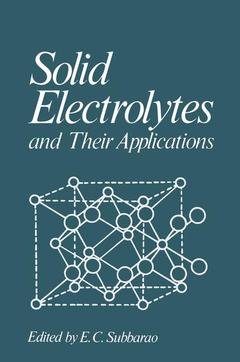Solid Electrolytes and Their Applications, Softcover reprint of the original 1st ed. 1980
Langue : Anglais
Coordonnateur : Subbarao E.

Defect solid state has been an area of major scientific and technological interest for the last few decades, the resulting important applications sus taining this interest. Solid electrolytes represent one area of defect solid state. The early work on defect ionic crystals and, in particular, the classic results of Kiukkola and Wagner in 1957 on stabilized zirconia and doped thoria laid the foundation for a systematic study of solid electrolytes. In the same year, Ure reported on the ionic conductivity of calcium fluoride. Since then, intense worldwide research has advanced our understanding of the defect structure and electrical conductivity of oxygen ion conductors such as doped zirconia and thoria and of the fluorides. This paved the way for thermo dynamic and kinetic studies using these materials and for technological applications based on the oxygen ion conductors. In the last few years we have seen the emergence of two new classes of solid electrolytes of great signifi cance: the fJ-aluminas and the silver ion conductors. The significance of these discoveries is that now (i) solid electrolytes are available which at room temperature exhibit electrical conductivity comparable to that of liquid electrolytes, (ii) useful electrical conductivity values can be achieved over a wide range of temperature and ambient conditions, and (iii) a wide variety of ions are available as conducting species in solids. The stage is therefore set for a massive effort at developing applications.
1. Defect Structure and Transport Properties.- 1. Introduction.- 2. Defect Structure.- 3. Experimental Methods.- 4. Materials.- 5. Concluding Remarks.- References.- 2. Limiting Factors in Measurements Using Solid Electrolytes.- 1. Introduction.- 2. Electronic Conduction in the Electrolyte.- 3. Maintaining a Desired Chemical Potential at the Electrode-Electrolyte Interface.- 4. Effects of Porosity, Inhomogeneity, and Inadequate Mechanical Properties.- 5. Experimental Uncertainties.- 6. Concluding Remarks.- References.- 3. Thermodynamic Studies of Alloys and Intermetallic Compounds.- 1. Introduction.- 2. Metallic Alloy Systems.- 3. Oxygen Dissolved in Metals and Alloys.- 4. Fluoride Cells to Study Carbides, Borides, Phosphides, and Sulfides.- 5. Conclusion.- References.- 4. Thermodynamic Properties of Oxide Systems.- 1. Introduction.- 2. Comparison of the Solid Electrolyte Method with Other Methods for Thermodynamic Measurements.- 3. Types of Solid Electrolytes Used in the Study of Oxide Systems.- 4. Thermodynamic Measurements of Oxide Systems with Cells Involving Oxide Solid Electrolytes.- 5. Thermodynamic Measurements of Oxide Systems with Cells Involving Fluoride Solid Electrolytes.- 6. Concluding Remarks.- References.- 5. Kinetic Studies.- 1. Introduction.- 2. Polarization Studies.- 3. Diffusion Measurements.- 4. Kinetics of Phase-Boundary and Diffusion-Controlled Reactions.- 5. Concluding Remarks.- References.- 6. Technological Applications of Solid Electrolytes.- 1. General.- 2. Oxygen Meters.- 3. Oxygen Transfer to and from Materials.- 4. Energy Conversion.- 5. Batteries with ?-Alumina Electrolytes.- 6. Solid State Ionics.- References.- 7. Fabrication.- 1. Introduction.- 2. Single Crystals.- 3. Polycrystalline Materials.- 4. Electrodes.- 5. Joining of Materials.-6. Conclusions.- References.
Date de parution : 10-2011
Ouvrage de 298 p.
15.2x22.9 cm
© 2024 LAVOISIER S.A.S.



